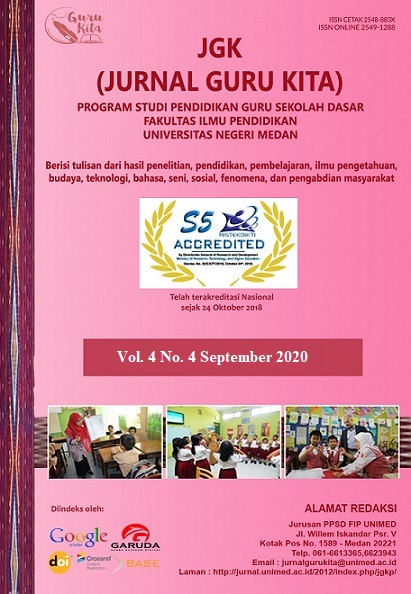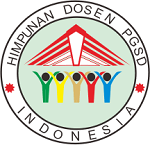PENGEMBANGAN MEDIA PEMBELAJARAN DOMINO MINUS DAN PLUS BERBASIS IT MATERI OPERASI HITUNG BILANGAN BULAT PESERTA DIDIK KELAS IV SEKOLAH DASAR
DOI:
https://doi.org/10.24114/jgk.v6i2.33435Abstract
Abstract : Development of Domino Minus and Plus Learning Media Based on It Operation Material Counting Integers Grade IV Elementary School Students. The problems in this study are the lack of use of learning media in the teaching and learning process, the lack of teacher skills in making IT-based learning media, the learning methods used in the learning process are still conventional, the students' mathematics learning outcomes in the arithmetic operations material of integer addition and subtraction are still is low. The purpose of this research is to develop learning media for IT-based domino Minus and Plus Media Operations Material for Counting Integers in the mathematics learning process so that student learning outcomes increase, especially in learning mathematics in the material for counting operations on integers, adding and subtracting for grade IV Elementary School. The type of research used is research and development (Research and Development) with the Borg and Gall model which consists of 10 stages, but in this study the researchers only reached stage 7, namely: 1). Potential and Problems, 2). Data Collection, 3). Product Design, 4). Design Validation, 5). Design Revision, 6). Product Trial, 7). Product Revision. Data collection techniques are interviews, questionnaires, tests, and documentation. Qualitative and quantitative data analysis techniques. The research subjects were the fourth grade students of SDN 050616 Tanjung Karo as many as 24 students. The results of this study show that the effectiveness of the IT-Based Domino Minus and Plus learning media can be seen from the results of the pretest, namely students who complete as many as 33.33% or only 8 students whose scores are above KKM 70 while students who are incomplete or below KKM 70 are 66.67% or 16 students. The results of the posttest were 83.3% of students who completed or 20 students with scores above KKM 70 while students who did not complete or below KKM 70 were 16.7% or 4 students. From the results of the pretest and posttest showed an increase in student learning outcomes seen from the number of students who completed as many as 83.3% or 20 students. Based on these results, it can be concluded that the use of IT-based Domino Minus and Plus media in learning is feasible and effective in improving student learning outcomes.Keywords: Development Research, IT-Based Domino Minus and Plus Media, Integer Counting Operations, Student Learning Outcomes.References
Aqib, Z., Diniati, E., Jaiyaroh, S., Khotimah, K. (2010). Penelitian Tindakan Kelas. Bandung : YRAMA WIDYA.
Arikunto, Suharsimi. 2010. Prosedur Penelitian : Suatu Pendekatan Praktik. Jakarta: Rineka Cipta.
Arsyad, A. (2011 & 2013). Media Pembelajaran. Jakarta : RajaGrafindo Persada.
Djamarah, S. B., Zain, A. (2016). Strategi Belajar Mengajar. Jakarta : RINEKA CIPTA.
Iskandar. (2010) . Metode Penelitian Kualitatif. Jakarta : Gaung Persada.
Kereh, T, Cycilia., Liliasari., Tjiang, C, P. (2015). Validitas Dan Reliabilitas Instrumen Tesmatematika Dasar Yang Berkaitan Dengan Pendahuluanfisika Inti. Jurnal Inovasi Dan Pembelajaran Fisika, 2(1), h. 41. Doi : https://core.ac.uk/download/pdf/267822994.pdf
Muriati, S. (2014). Pengembangan Bahan Ajar Biologi Sel Pada Program Studi Pendidikan Biologi UIN Aluddin Makassar. Jurnal Florea, 1(2), h. 17. DOI: 10.25273/florea.v1i2.383
Purwanto. (2011). Evaluasi Hasil Belajar. Yogyakarta : PUSTAKA PELAJAR.
Sugiyono. (2017). Metode Penelitian Pendidikan: Pendekatan Kuantitatif, Kualitatif, dan R&D. Bandung: ALFABETA.
. (2018). Metode Penelitian Pendidikan: Pendekatan Kuantitatif, Kualitatif, dan R&D. Bandung: ALFABETA
Downloads
Published
How to Cite
Issue
Section
License
Authors published with the JGK (Jurnal Guru Kita) agree to the following terms:
- Authors retain copyright and grant the journal the right of first publication with the work simultaneously licensed under a Creative Commons Attribution License (CC BY-SA 4.0) that allows others to share the work with an acknowledgment of the work's authorship and initial publication in this journal.
- Authors are able to enter into separate, additional contractual arrangements for the non-exclusive distribution of the journal's published version of the work (e.g., post it to an institutional repository or publish it in a book), with an acknowledgment of its initial publication in this journal.
- Authors are permitted and encouraged to post their work online (e.g., in institutional repositories or on their website) prior to and during the submission process, as it can lead to productive exchanges, as well as earlier and greater citation of published work. (See The Effect of Open Access)




























